
Sofort lieferbar (Download)
This book presents a comprehensive description of the emerging technology of cellular neural networks (CNNs), the first general purpose analog microprocessors with applications including real-time image and audio processing, image recognition, and the solution of partial differential equations. It discusses some realistic industrial applications of CNNs (including automatic fruit classification, nuclear magnetic resonance spectra image processing, environmental modeling and simulation for pollution distribution forecast). Particular attention is paid to the study of CNNs in the context of nonlinear circuit theory. Emphasis is also given to chaotic oscillators and their application in secure communication and spread-spectrum systems. Discussed in addition is the subject of spatio-temporal dynamic phenomena in two-dimensional CNNs. It is shown how traveling wavefronts, spirals, and Turing patterns can develop in a regular and topologically simple array. The book is completed by the description of a real CMOS discrete-time switched-current chip implementation of a CNN. The book offers thorough discussions that range from issues at the system-level, which are characterized by a rigorous analytic approach, to the technological and IC design aspects. Examples, simulation studies and experimental results complement the theoretical results throughout.
Inhaltsverzeichnis
I. Circuit Theory and Applications of CNNs. - 1. CNN Basics. - 2. Some Applications of CNNs. - 3. The CNN as a Generator of Nonlinear Dynamics. - 4. Synchronization. - 5. Spatio-temporal Phenomena. - 6. Experimental CNN Setup and Applications to Motion Control. - II. Implementation and Design. - 7. A Four Quadrant S2I Switched-Current Multiplier. - 8. A One-Dimensional Discrete-Time CNN Chip for Audio Signal Processing. - A. Mathematical Background. - A. 1 Topology. - A. 2 Operations and Functions. - A. 3 Matrices. - A. 4 Dimension. - A. 5 Dynamical Systems: Basic Definitions. - A. 6 Steady-State Behavior. - A. 6. 1 Classification of Asymptotic Behavior. - A. 7 Stability. - A. 7. 1 Stability of equilibrium points. - A. 7. 2 Stability of Limit Cycles. - A. 7. 3 Lyapunov Exponents. - A. 8 Topological Equivalence and Conjugacy, Structural Stability and Bifurcations. - A. 9 Silnikov Method. - A. 10 Particular Results for Two-Dimensional Flows. - B. Library of Templates. - References.
Produktdetails
Erscheinungsdatum
06. Dezember 2012
Sprache
englisch
Seitenanzahl
273
Dateigröße
24,42 MB
Reihe
Springer Series in Advanced Microelectronics
Autor/Autorin
Paolo Arena, Luigi Fortuna, Gabriele Manganaro
Verlag/Hersteller
Kopierschutz
mit Wasserzeichen versehen
Produktart
EBOOK
Dateiformat
PDF
ISBN
9783642600449
Entdecken Sie mehr
Pressestimmen
From the reviews:
" The book is divided into eight chapters and each of them guides us through one area where the CNNs can be used . I recommend the publication to everybody, who is interested in the CNN and its application and implementation, but also to those who face some of the technologies described there, such as nonlinear dynamics, synchronization, signal processing or motion control, because the CNN can show a quite novel and beneficial point of view. " (Václav Dekanovský, Neural Network World, Vol. 15 (5), 2005)
Bewertungen
0 Bewertungen
Es wurden noch keine Bewertungen abgegeben. Schreiben Sie die erste Bewertung zu "Cellular Neural Networks" und helfen Sie damit anderen bei der Kaufentscheidung.







